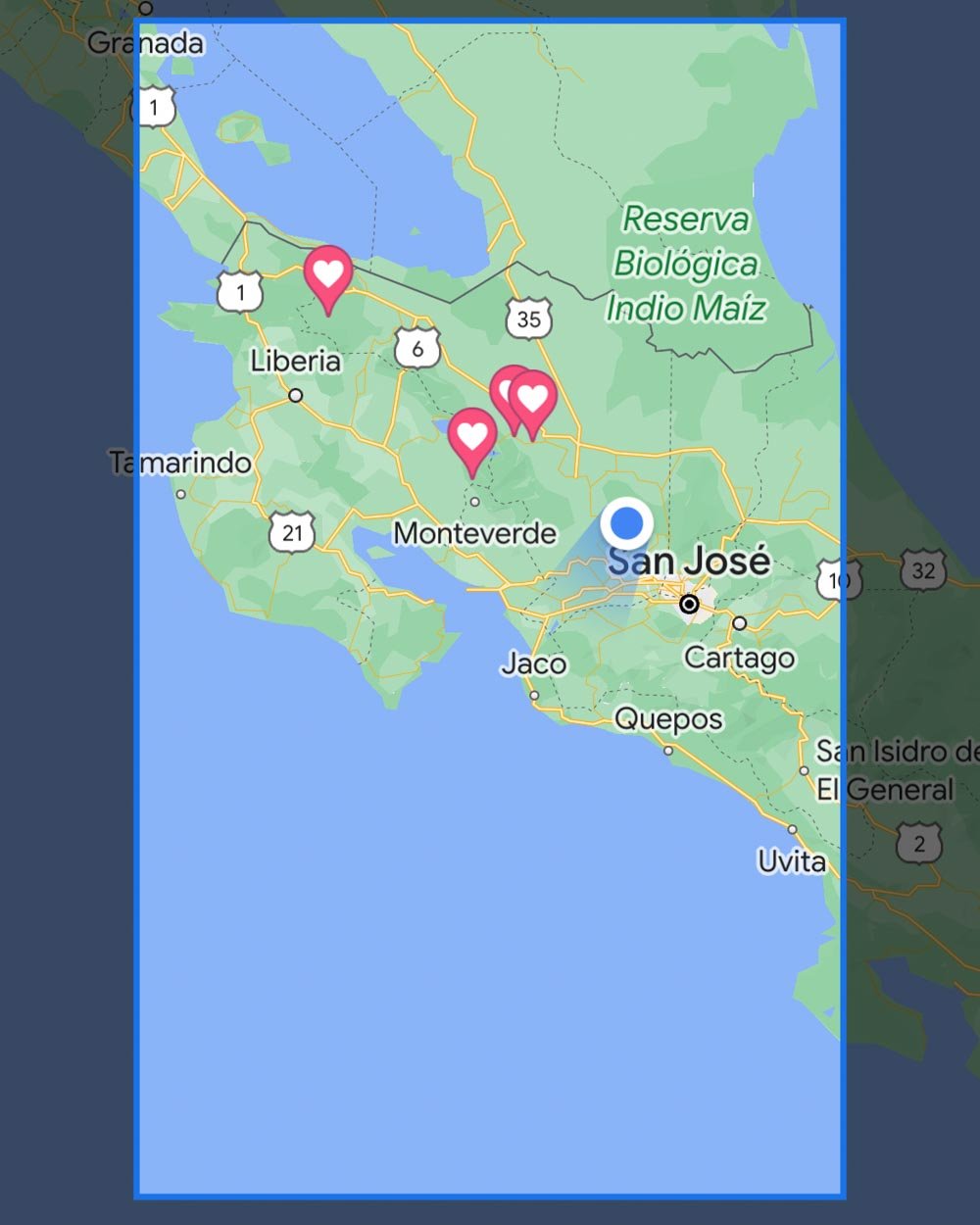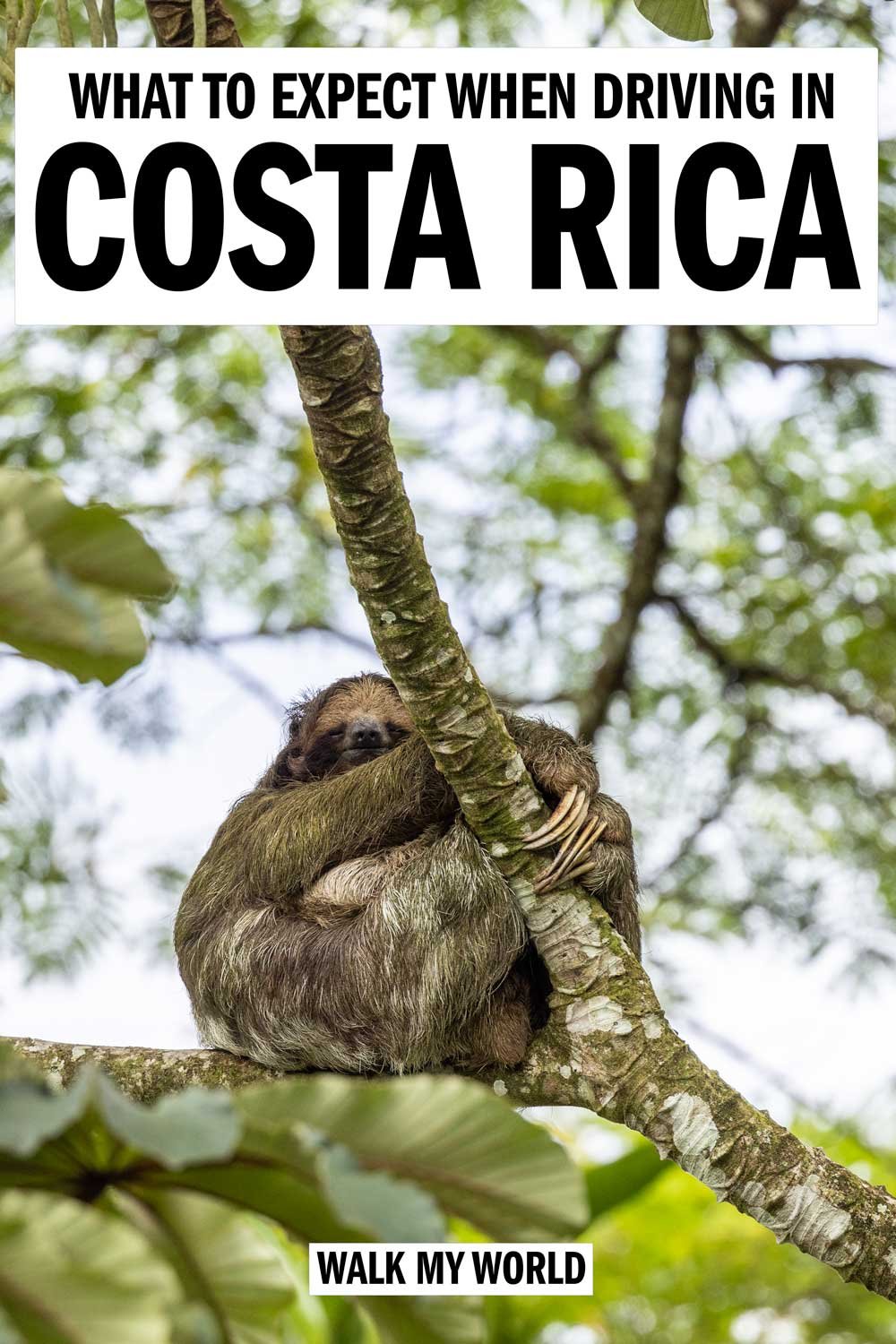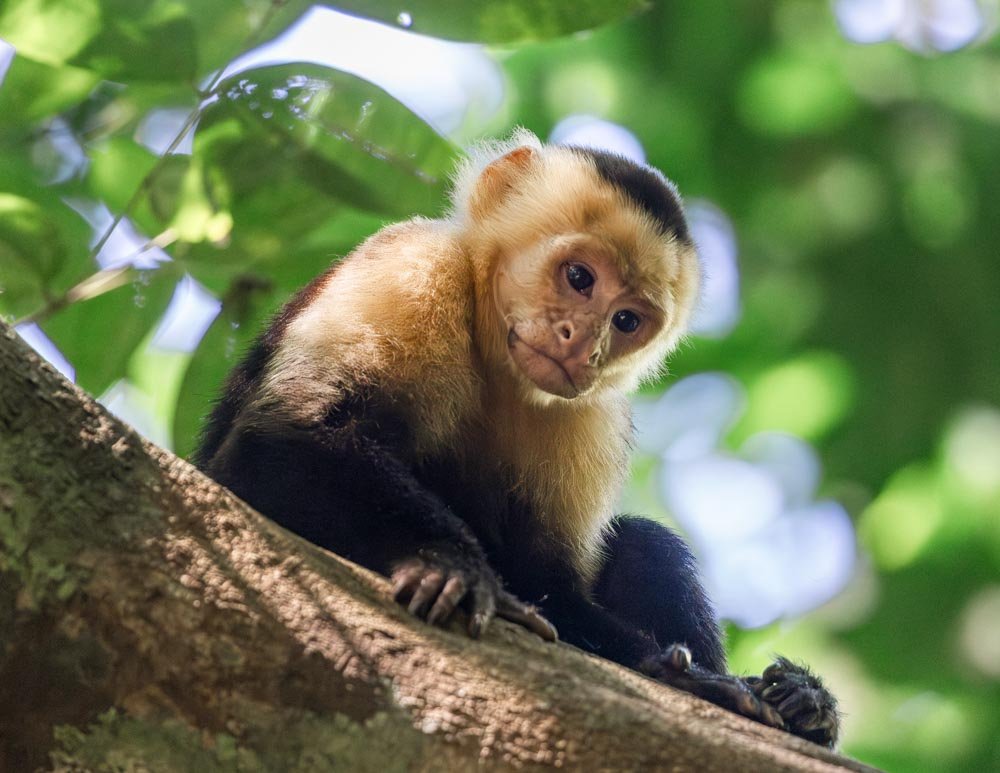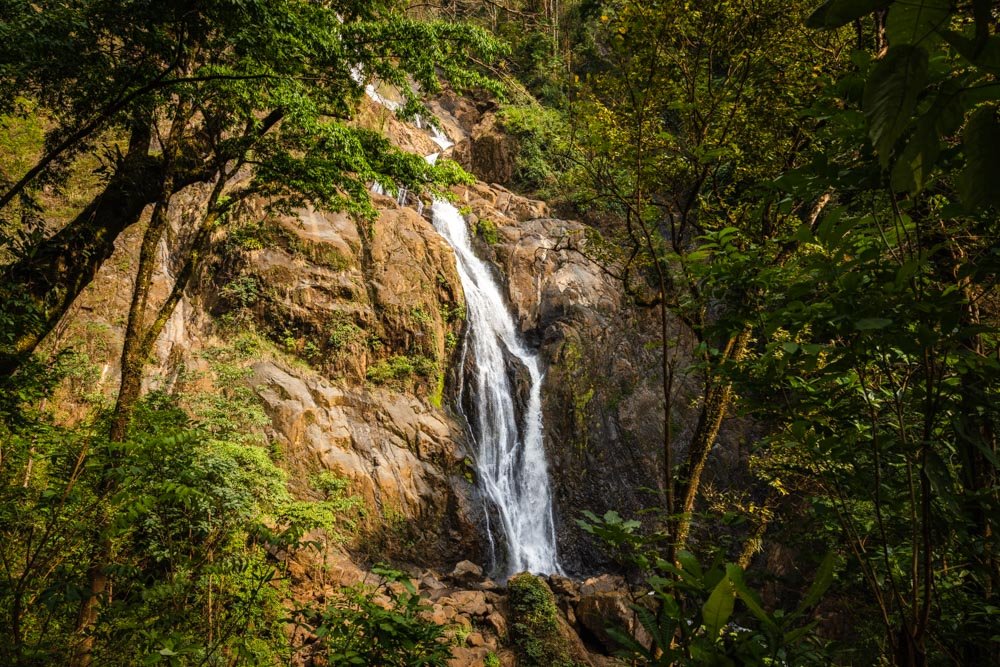Costa Rica is the perfect country for a road trip - there are endless incredible places to stop, many of which can only really be accessed with your wheels. Having a vehicle allows you to set your own timetable and not have to rely on public transport or expensive taxis.
However, driving in Costa Rica may not be for everyone. Whilst the distances are small, journeys are often slow, and the roads can be in poor condition. After road tripping for six weeks, we’re going to break down what it’s actually like to drive as a tourist in Costa Rica: the pros, the cons, and what you need to know to make your experience easier.
Things you need to know about driving in Costa Rica as a tourist
1. The rental car scam
We hate starting on such a negative, but it’s best to get the worst bit out of the way first. Unfortunately there are a lot of rental companies that will scam you when hiring a car. Before you get completely put off, you can mitigate the risks by following all the tips in our rental car scam guide.
We rented two different cars in Costa Rica and picked the companies very carefully. We didn’t have trouble, but one look at the Google reviews of many car rental companies will quickly show you that scams are common. If you follow the advice in our guide then you hopefully won’t have any trouble.
The standard of car may not be what you’re used to - you might well get a beaten up car, however, that’s our favourite kind of rental car as it’s hard to charge for damage to a car already covered in dents and scratches!
2. Having a 4WD/SUV is nice, but may not be necessary
It’s worth noting that not all unpaved roads require a 4WD. Many of the unpaved roads in Costa Rica are pretty flat and in reasonably good condition. However, there are some which are truly wild and require serious off roading skills.
Whether you need a 4WD/SUV will depend on what you are looking to do. If you plan on going to the most popular places (La Fortuna, Manuel Antonio, the beaches etc) then you’re unlikely to come across anything but paved roads that are pretty well maintained. If this is your plan, then having a 4WD is more about comfort than necessity. Just be sure when choosing your accommodation that it’s not on a steep gravel road, which is quite common even in the touristy areas, especially if using Airbnb.
If you plan to go to places like Monteverde (there’s some paved roads, but a lot of gravel tracks) or to off the beaten track destinations, then you may prefer a 4WD/SUV. It’s not that you can’t access them with a smaller car - for many you absolutely can - it’s just that the suspension and build of the bigger car will be a lot more comfortable on some of the bone shaking roads.
Some hotels but more commonly Airbnbs are on unsealed roads, but don’t mention it on their listings on booking websites. It’s worth checking the reviews to see if the roads you’ll be using are sealed or not, you are almost guaranteed to find out from the reviews.
It’s also worth noting that our opinion is based on driving in the dry season, so if you visit in the wet season, the conditions can be a lot more challenging and you may want that 4WD.
El Santuario near Liberia
3. Adventure seekers will come across a lot of unsealed roads
If you plan on visiting some of the lesser visited waterfalls, swimming holes, hiking trails and hot springs, then you will inevitably come across unsealed roads that stretch for miles. Some of these roads will have tiny patches of paved road for relief, but then dive back into gravel.
These roads are the very faint roads on Google Maps and even having a road name or number won’t guarantee it’s paved! As we alluded to earlier, some (but not all) of the roads around Monteverde - a very popular place - are gravel, which can be a little unnerving with the steep drops either side.
Most rental car companies don’t explicitly state that you can’t go on an unsealed road (unlike countries such as Australia, where they will specifically state you can’t take the car on an unpaved road). However, whilst the rental car company may allow you to go on an unpaved road, the insurance on your rental car may not cover damage or accidents on these roads.
The Hot Springs at Santa Maria Sector
4. Driving over potholes is a national pastime
Costa Rica has a huge problem with potholes; they are everywhere. Even the major highways can have a sneaky pothole, waiting for you to smash into. They can vary from occasional ones on the highways, to never ending ones on roads around Bajos Del Toro, Monteverde and Liberia.
Often we preferred the gravelled/unsealed roads to the paved ones, as many felt like a never ending cluster of craters to navigate.
Make sure you drive slowly and patiently, as you don’t want to blow a tyre out or damage your car!
5. The unmarked speed bumps
Don’t ask us why, but Costa Rica has a lot of unmarked speed bumps in the most random of places. it is common to find yourself crashing over a speed bump you never knew was there. The speed bumps often have no paint, no signage and can even be in a place you’d never expect (such as at the top of a hill).
It tends to be in residential areas, but can often be on a rural road where no one lives.
6. The drivers in Liberia are some of the friendliest we’ve seen
This was a surprise, but we found that Costa Rican drivers overall were pretty good, but the drivers in Liberia were on another level. For some reason, everyone there was incredibly considerate, patient and really friendly. We lost track of the amount of times we saw cars stop to let us out at busy junctions, allowed us to make pretty inconvenient turns, or let us pass on a one-way road when it was their right of way.
Whilst they aren’t quite as friendly in the rest of the country, it’s rare you’ll hear a car horn, or see unnecessarily aggressive manoeuvers, which are common in a lot of countries.
You’ll often see a slow truck indicating left on a highway - this is a sign that it is clear for you to overtake them! This was a complete novelty for us as we’ve never seen it anywhere else. However, it’s just as common to be overtaken by trucks doing over 100kph in a 60 kph zone.
We never felt on edge because of the drivers in Costa Rica. Having driven in Israel, Jordan, Bali and many countries where you feel like you’re a character in Mario Kart, we found Costa Rica to be a relatively relaxed and easy going place to drive.
That’s not to say you won’t meet any tailgaters or kamikaze drivers, but generally it was pretty good.
7. The distances are small, but the journeys are long
One of the surprising things about Costa Rica is that it can take a long time to go a pretty short distance, especially during rush hour, or when travelling between Jaco and San Jose. We thought that a country this small would mean quick journeys, but that is rarely the case.
This is primarily because the majority of roads are narrow and windy, meaning you can’t often get above 50kph. You can pick up speed on the highways, but the majority are single lanes and busy, and it’s common to be stuck crawling behind a truck that is trudging uphill. However, there are places that simply clog up because of the amount of cars on the road.
It’s worth taking into consideration the times that Waze and Google maps state, rather than just looking at the distances, and add more time to account for the traffic.
8. Download your maps
Sim cards in Costa Rica are expensive, offer very little data for the money and have huge blackout spots (depending on which carrier you go for, Kolbi has the best coverage, but is the most expensive), so we recommend having offline maps to get around. It’s free to download Google maps, and it’s surprisingly simple.
1. Go to the Google maps app and click on the icon on the top right
2. Click “offline maps”
3. Click “select your map” and pinch to select your area. You may have to do this multiple times to cover the whole area you want to visit.
4. Wait for the maps to download, and they’ll work offline.
You will need to do this at least twice to cover the whole of Costa RIca.
9. There isn’t much signage or direction
The most common thing we came across where there was no direction at all was at intersections. No one had the clear right of way and it was a complete free for all.
At first this can be unnerving, but eventually you’ll see that people take turns and often there seems to be a direction that tends to have priority. Have patience and try to edge out if you’re at a junction where it isn’t entirely clear what you’re meant to do.
10. The speed limits change a lot
There isn’t much signage around speed limits in Costa Rica (there’s more paint on the road telling you the speed limit than signs), but there’s a rule of thumb as to how fast you can go.
We’d read that the maximum speed is 100 kph, but in general we saw the top speed on a highway was 80 - 90kph. Non-highways in rural areas tended to be 60kph unless otherwise stated, built up areas were 40kph and residential streets were often 20kph. This isn’t always the case, but it was for the majority of the time.
The more confusing aspect was Highway 1, especially around Liberia, which seemed to change between 90kph and 40kph every 500m. Keep your eyes peeled and stick to the speed limits, even if you’re the only person in the country who seems to do so.
The Essentials for driving in Costa Rica
Which side of the road?
Costa Rica drives on the right side of the road.
How to avoid going on a rough 4WD road
Costa Rica is full of unpaved roads and apps like Google maps do have a tendency to take you on a more adventurous route than needed. We’ve found ourselves scaling steep dirt roads, just because our sat nav decided to take us the shortest distance, rather than the safest route.
Before you go, check the route. The easiest way to judge the kind of road you are on is to see if it has a road number. Highways are pretty clear, but a minor road with a number tends to be paved (this isn’t always the case, but is more often than not). If you are given a choice of a route that is 5km long, but takes 20 minutes, or a route that is 50km long and takes 50 minutes, always take the latter.
Driving in Costa Rica at night
This is something we saw come up a lot and we’re not really sure why. Driving in Costa Rica at night in our opinion is no more dangerous than most places in the world, however there are a few things you should be aware of.
A lot of areas do not have street lighting, so you are reliant on your headlights, which on older cars aren’t great.
It’s harder to see those pesky potholes in the dark. Just take it slow on the roads where they can feel like you’re driving on the surface of the moon.
You may encounter wildlife. We barely saw anything on the roads, but it is more likely at night than during the day.
On the upside, being in the dark is easier for turnings with blind corners as you’ll see the headlights of an oncoming car way before you see them!
Overall, I wouldn’t see driving in the dark in Costa Rica as any more problematic than anywhere else in the world, but if you are nervous than make all journeys in the day time.
Parking rules in Costa Rica
At first glance, there’s very little restrictions on parking in Costa Rica. You’ll see the occasional paid parking area in the cities (requiring an app) or a sign saying “No estacionar”, but otherwise it looks like you can pretty much park anywhere.
However, there’s a more subtle “no parking” sign that can get you a hefty fine if ignored - the yellow paint. This is often on a curb, but we’ve also seen it on a grill covering a drain, or just splashed in places you don’t expect. Even if you see other people parked in the yellow zones (which you almost certainly will) it’s best to look for another spot.
Keeping your vehicle and belongings safe
Whilst Costa Rica is generally very safe, don’t leave anything of value inside your parked car. We’ve heard of some tourist’s having their cars broken into and their camera, laptop and valuables being stolen. Wherever possible, park in a secure car park (a lot of tourist attractions will have someone who keeps an eye on the cars). If you have anything in your car, cover it up.
We had no problems whatsoever, but that may have been because we were careful!
River crossings
Before visiting, we’d read that river crossings were quite common, but in six weeks of a lot of driving (and a lot off the beaten track places) we only did two river crossings. It isn’t a common occurrence in Costa Rica if you’re in the areas most tourists visit, and it’s only likely if you on a pretty rural road!
However, it’s best to be prepared. We don’t recommend attempting river crossings in the rainy season unless you have experience. In the dry season, check the depth before you attempt to cross. Continue at a steady speed and don’t stop!
The toll roads
On the whole, there aren’t many toll roads in Costa Rica and those that you do find are pretty cheap. We found that tolls tended to range from 250 Colones (USD $0.50) to 850 Colones (USD $1.60).
The worst offender for tolls we came across was Route 27 which joins San Jose to the Pacific Coast. We went through five separate toll booths on the same road, which created endless traffic jams as 10 lanes of toll booth traffic tried to squeeze into a single lane.
All tolls we came across accepted card or cash, so you didn’t need to worry about your rental car company hitting you with a hefty admin bill at the end of your trip. Just make sure you opt for the manual lane, as they also have quick pass lanes, which neither of our rental cars provided.
How to rent a car stress free in Costa Rica
Go on any forum or Google review of a rental car company and you’ll find your blood pressure rising. At times, it feels like renting a car in Costa Rica is just one big scam waiting to ruin your trip.
Whilst you do have to be switched on when booking your rental car in Costa Rica, if you follow our tips about avoiding the scam, you will be fine. So long as you have the right insurance included in the booking, you’ll very likely have no issues.
We use Rentalcars.com for the reason that it provides pretty good prices and all the relevant information you need in the search results. On the photo below, you can see it quickly gives you a rating of the rental car company, what type of car and transmission it is, the mileage policy and a tab that leads to what insurance is covered.
You can compare the results pretty quickly and get the car you want. Just make sure you check that each listing has:
Free cancellation
Unlimited mileage (or the enough miles for your trip)
Third party coverage (in the important information section)
Collision damage waiver (also in the important information section).
Top Tip - Sometimes hiring for a few more days will save you money. This may sound counterintuitive, but we looked at hiring a car for 28 days and the price kept coming up as over $3,000 USD or $107 USD per day.
It wasn’t until we tried adding two days that everything changed, and we suddenly got a price of $1,296 USD or $40.50 USD per day. By booking for 32 days we suddenly found a company that gave a big discount.
You can fill in the boxes below to have a quick look at the current prices for car rental in Costa Rica.
This post may contain affiliate links, meaning at no additional cost to you, we will earn a small commission if you click through and decide to make a purchase. This helps towards the costs of running our website. Thanks for your support.









































